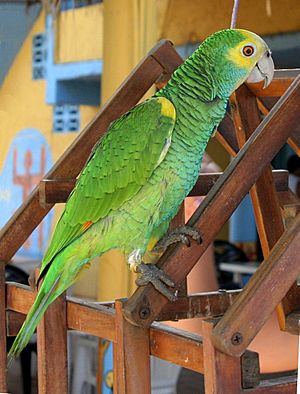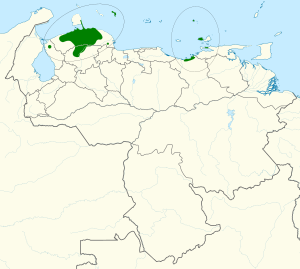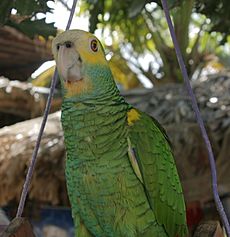Yellow-shouldered amazon facts for kids
Quick facts for kids Yellow-shouldered amazon |
|
|---|---|
 |
|
| A pet on a wooden climbing frame in Venezuela | |
| Conservation status | |
| Scientific classification | |
| Genus: |
Amazona
|
| Species: |
barbadensis
|
 |
|
The yellow-shouldered amazon (Amazona barbadensis), also known as the yellow-shouldered parrot, is a type of parrot. It lives in dry areas of northern Venezuela, including the Venezuelan islands of Margarita and La Blanquilla. You can also find it on the island of Bonaire in the Caribbean Netherlands. This parrot used to live on Aruba but is no longer found there. However, a group of these parrots now lives on Curaçao.
Contents
How Scientists Name the Yellow-Shouldered Amazon
The yellow-shouldered amazon was first described in 1738 by a scientist named Eleazar Albin. He called it the "Barbadoes parrot" because he thought it came from Barbados.
Later, in 1788, another scientist, Johann Friedrich Gmelin, gave it the scientific name Psittacus barbadensis. The word barbadensis still refers to Barbados, even though the parrot doesn't live there. Today, this parrot is part of a group of about 30 other parrot species in the genus Amazona.
What Does the Yellow-Shouldered Amazon Look Like?
The yellow-shouldered amazon is mostly green and grows to about 33 centimeters (13 inches) long. It has a white forehead and a yellow top of its head. Its eyes are surrounded by a white ring.
You might also see yellow on its "shoulders" (the bend of its wing) and on its upper legs. Its throat, cheeks, and belly can sometimes look a bit bluish. Like many Amazona parrots, it has dark blue tips on its flight feathers and a red patch on its wing.
You can tell this parrot apart from the similar orange-winged amazon because the orange-winged one doesn't have yellow on its shoulders or blue around its eyes. The yellow-shouldered amazon also has slightly higher-pitched calls.
Where the Yellow-Shouldered Amazon Lives
This parrot is found only in northern Venezuela and nearby islands like Bonaire. On Margarita Island in Venezuela, it used to live everywhere. Now, it only lives on the Macanao Peninsula because the eastern part of the island has become very developed for tourists.
It used to live on Aruba but disappeared from there by 1947. However, some have been introduced to Curaçao. Unlike many other parrots, the yellow-shouldered amazon prefers dry places. It lives in desert scrub and dry forests.
Yellow-Shouldered Amazon Behavior
What the Yellow-Shouldered Amazon Eats
These parrots eat fruits, seeds, and flowers. They often eat parts of cactus plants. They can survive with very little water because they get most of their moisture from their food.
This is especially true on La Blanquilla, a small island with no natural water sources. The cacti they eat are full of liquid, which helps them stay alive in their dry home.
Reproduction and Life Cycle
Yellow-shouldered amazons usually make their nests in holes. They can use holes in trees, cliffs, or even cacti. A female parrot will lay between 2 and 5 eggs.
These parrots are very social. They sometimes gather in large groups, called roosts, in tall trees. These groups can have as many as 700 birds! The parrots on Bonaire seem to breed a bit slower than others of their kind.
Status and Conservation Efforts
Scientists believe there are between 2,500 and 10,000 yellow-shouldered amazons left in the wild. Their numbers have been decreasing in many areas.
This parrot is considered a "Vulnerable" species on the IUCN Red List of Threatened Species. This means it's at risk of becoming endangered. The main reasons for this are:
- Loss of their natural home (habitat).
- Their small population size.
- Their limited living area.
- Too much hunting for the pet trade.
On La Blanquilla island, problems include feral cats hunting them and people hunting them. The parrot is also listed on Appendix I of CITES, which means it's highly protected from international trade.
Thanks to local groups like the Venezuelan NGO Provita, illegal hunting has been greatly reduced in some areas. For example, on Margarita Island, the parrot population was as low as 750 birds in 1989. But thanks to conservation efforts, their numbers grew to an estimated 2,400 by 2002. These efforts included breeding parrots in captivity and then releasing them into the wild, which was very successful in the 1990s.
See also
 In Spanish: Loro de hombros amarillos para niños
In Spanish: Loro de hombros amarillos para niños



